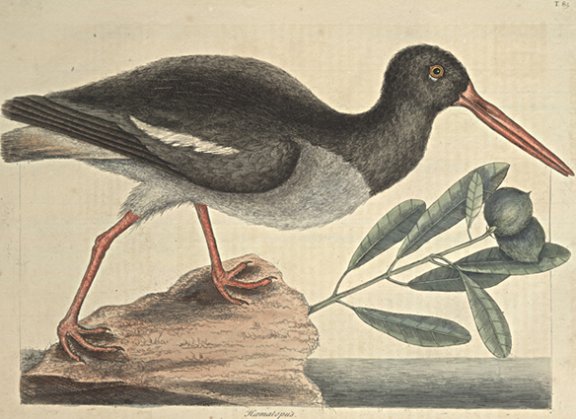Plate Number: I 85Haematopus: The Oyster Catcher Weighs one pound and two ounces; the Bill long, streight and of a bright red colour, contracted near the basis, and towards the end compress'd: the Irides of their Eyes are yellow, encompassed with a red Circle: the whole Head and Neck black, having a spot of white under the Eyes; all the under part of the Body, dusky white: the larger Quill-feathers are dusky black: the Tail is short, black towards the End, and towards the Rump white: the upper part of the Body and Wings, brown, except a broad white line, which runs along the middle of each Wing; the Legs are long and thick, and of a reddish colour. It has only three fore-toes, wanting the back-toe. Their Feet are remarkably armed with a very rough scaly skin. In Rivers and Creeks near the Sea there are great quantities of Oyster-banks, which at low Water are left bare: On these Banks of Oysters do these Birds principally, if not altogether, subsist; Nature having not only formed their Bills suitable to the Work, but armed the Feet and Legs for a defence against the sharp edges of the Oysters. The Hens differ from the Cocks in not having the red circle round their Eyes, and their Bellies are of a more dirty white than in the Cocks: In the Maw of one was found nothing but indigested Oysters. This Bird seems to be the Haematopus of Bellonius, Will. p. 297. notwithstanding there is some small difference in their description. I have seen them on the Sea Coasts both of Carolina and the Bahama Islands. Frutex Bahamensis foliis oblongis succulentis, fructu subrotundo unicum nucleum continenteThis grows to the size of a small Tree; the leaves stand by pairs on foot-stalks about an inch long; they are long, thick and succulent: at the ends of the stalks grow in pairs, and sometimes singly, round flat Seed-vessels, about the breadth of a shilling: the fruit is of the substance of a Bean, and, like that, divides in the middle: it is cover'd with a thin membrane of a pale green colour. I had no opportunity of seeing the Blossoms, tho' I was told they were very small and white. The Bark of this Tree is used for tanning of Sole-leather. |